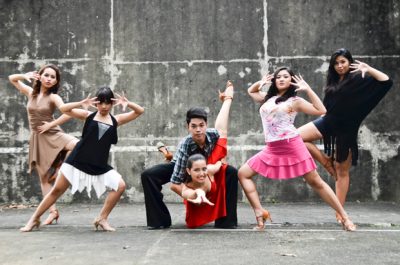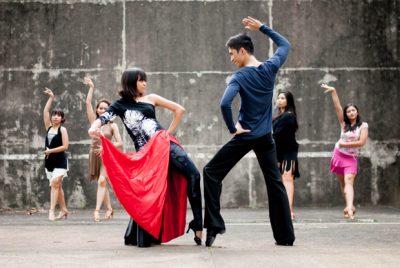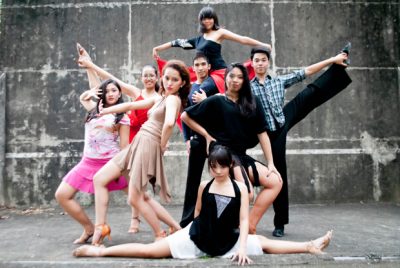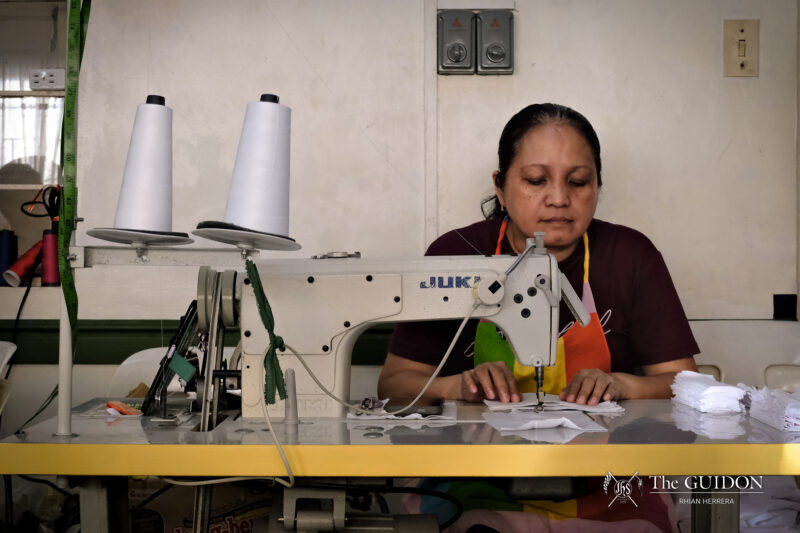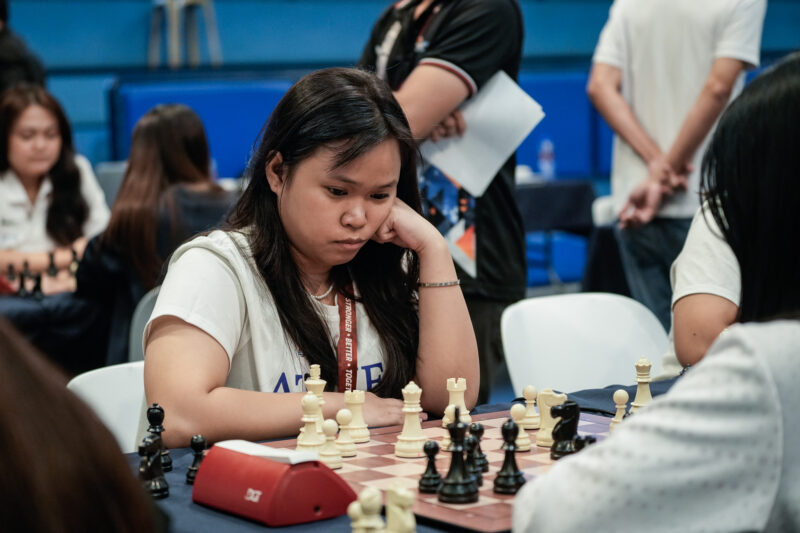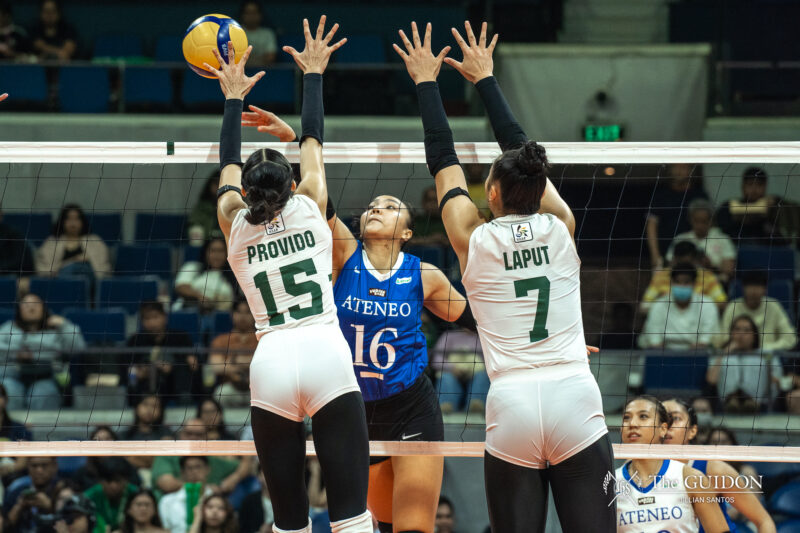
NOT STRICTLY BALLROOM. The Ateneo Dancesport Club (ADSC) performs a range of dance styles, from paso doble to the jive. Photo by Kat A. Mallillin and Christie K. Lim.
The studio is cold. The hum of the air conditioner overpowers the voices of those taking dancesport midterms, and as a result, no one can be heard speaking. Onstage, four students teeter dangerously in high heels, expressions determined. Then, as the music starts, they move, counting under their breaths, “One, two, three, four, and five…”
If everyone could start dancesport, also known as competitive ballroom dancing, with the grace required, life would be perfect. There are quite a few who move neatly and add flourishes confidently, but most can’t. Some Ateneo physical education students, who have been under internationally acclaimed instructor Belinda Adora, know just how challenging dancesport is. It also probably doesn’t help that the number one rule is to not stop dancing until the music stops.
In the mood for a dance
To the typical person, dancesport looks like it’s a world away. Television series that show fully made-up women in flashy costumes and high heels who dance to music that is a far cry from those popular today separate the dancer and the audience.
Fortunately, there has been a shift in dancesport’s portrayal in the media. From traditionally being looked upon as a pastime for grandparents, shows like Dancing with the Stars are bringing it to younger audiences. Dancesport instructors are no longer old and rigid; rather, many are in their twenties or thirties. One of them is Adora, the coach of the Ateneo Dancesport Club (ADSC).
Known as the Philippines’ Dancing Queen, Adora was born and raised in Samar before coming to Manila. However, she took a detour from her studies at Centro Escolar University, joining the Metropolitan Theater Dance Company instead. Soon, she was winning weekly dancesport competitions, despite only having a background in jazz and ballet. In fact, she describes her first international dancesport competition in Taiwan as “parang katuwaan lang (just for fun)” before she and her partner realized how seriously other dancers took it.
Adora went on to become the dancesport champion in the 23rd Southeast Asian (SEA) Games in 2005. However, after graduating from college in 2007, she began wondering about the future. “Sayang ang ininvest sa akin [kung] mawawala lang (It would have been a shame if everything invested in me went to waste),” she said, “so I [wanted] to share it.”
What few know is Adora’s real reason for going to the Ateneo soon after her graduation. “My purpose was not to make it a class, just a club,” she says in a mix of English and Filipino. “Pero pagdating ko dito, sinabi nila (When I arrived, they said), ‘Can you give me your resumé? Transcript?’”
It was only when she was abroad again that she received a call asking if she could return, being told, “So, your schedule is…”
Stepping up
ADSC training starts immediately after dancesport class. Dressed in loose shirts and shorts, members sit on the wooden floor behind ADSC President Jean Hamada. Pop music plays as members warm up with rotations, bends and splits that look physically impossible. Then, after a quick water break, Hamada reviews the standard rumba walk, where pointed toes touch the floor, followed by the ball of the foot and the heel—a movement far more difficult than it looks.
Though it is challenging, learning such a step is just a stepping stone. Perhaps it can even be compared to how both dancesport and the ADSC have grown: slowly and painstakingly.
Though competitive ballroom dancing has been around for more than a century, it was only in 1997 that the International Olympic Committee recognized the World Dancesport Federation as the leading body for dancesport.
It took the Philippine government longer to see its promise. Dancesport veteran Juliet Genio credits Adora’s winning the gold medal during the SEA Games with getting the government to see its potential. “Now dancesport is included in Batang Pinoy athletic meets,” says Genio. “Even private school athletic meets have started having it. I think that it is beginning to go around nationwide.”
In recent years, the government has begun to support the Dancesport Council of the Philippines, but the sport is still new at the Ateneo. On campus, dancesport only arrived with Adora in 2007, two years before the ADSC was born.
Nevertheless, since its inception, ADSC has come to be noted in school, given its participation during OrSem, the Company of Ateneo Dancers’ Rhythm in Blue, and the different school nights.
However, it still lacks a solid presence, with only 30 members. “We’re still [few] and inexperienced,” says Hamada, about the ADSC’s attempt to transition from being a club to being an accredited student organization. “We’re relatively new. We’re not ready, like the other orgs that have a lot of projects, a lot of money, a lot of things that they’re doing.”
Feel the heat with somebody
ADSC’s biggest problem, however, has to do not with structure, but with the sheer lack of male dancers. After all, dancesport isn’t done solo; a partner is required every step of the way. Dances such as the paso doble, which was inspired by the fiery movements of bullfighters and their adversaries, require the passion and ferocity of both dancers involved.
But the fact is that only few males join the ADSC, leaving its members, majority of whom are female and qualified to join competitions, without partners. “It’s hard to find a partner because you need to be compatible with them,” says political science senior Khristine de Leon, who has been with the ADSC for three years. “Their height, their weight, your connection—it’s not as simple as simply finding a guy to dance with.”
According to Adora, the lack of males wasn’t a problem when dancesport was new. “The [guys] were so excited,” she says. She recalls one moment during her first teaching semester, close to Valentine’s Day, when she went to the back of the dance area and saw all her male students there, ready with flowers. “[I said], ‘Why are you all here?’” she narrates, suppressing a grin. It was then that the students explained, “Ma’am, you know, for [the girls during] the tango,” which they demonstrated by putting roses between their teeth.
Nowadays, however, misconceptions abound. “People think that guys who are into the sport must be gay,” says de Leon. Jessie Genio, a psychology major and Juliet Genio’s daughter, adds, “What [people] don’t realize is that the guy steps are very different from the girl steps and that you need to look masculine in order to look good dancing Latin, even if you really are gay.”
Hamada agrees. “If you see how [the guys] partner, [you’ll see that] they have to be a man, to prove their masculinity. It’s really challenging for other guys to be part of dancesport,” she says, noting another side of the issue. “It’s hard for them.”
Genio thinks it’s just a matter of confidence. “I think [guys] get discouraged because there are few guys, but more and more join every year,” she says. “On the other hand, some guys think that dancesport is just a way to hang out with chicks and dance with them. All I have to say is”—and here she laughs—“they won’t last.”
Last dance
There’s no question about dancesport’s legitimacy as a discipline and as an art—or about ADSC’s part in it. With an outside partner, ADSC member Jan Cerezo has placed in various competitions; he even won first place in the intercollegiate Latin-American division for the 2011 Lilian’s Cup, among others.
Past ADSC members have also placed in the Philippine Starball, the National Philippine Dancesport Championship, and their very own Ateneo Open Dancesport Competition. Closer to home is the fact that the past three presidents of the ADSC have all been recognized in the Loyola Schools Awards for the Arts.
The main problem, perhaps, is how little attention has been paid to it in school by the students—and while seniors and super seniors try dancesport in their final year, the practice goes nowhere without people they can dance with.
But such a situation can be compared to dancesport itself, with the various roadblocks that need to be encountered before the sport can be recognized and appreciated. In fact, it resonates with something Hamada said when dancesport class ended earlier that day. Watching the last students walk offstage, she explains, “You’re not supposed to stop. [Continuing] shows that you’re putting effort into it. Even if your timing is off, you’re supposed to continue.”
- Photo by Kat A. Mallillin and Christie K. Lim.
- Photo by Kat A. Mallillin and Christie K. Lim.
- Photo by Kat A. Mallillin and Christie K. Lim.
- NOT STRICTLY BALLROOM. The Ateneo Dancesport Club (ADSC) performs a range of dance styles, from paso doble to the jive. Photo by Kat A. Mallillin and Christie K. Lim.


